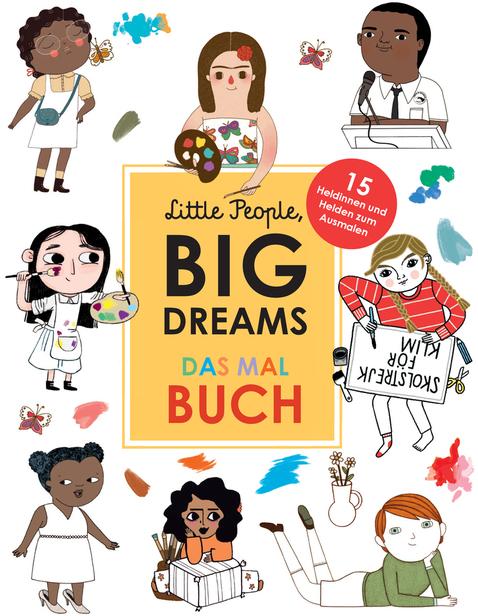

Mummy, am I pretty? How to encourage body positivity in young children
Beautiful, thin, fat, curly... My daughters are beginning to scrutinise and judge their bodies – and this despite being a long way off using social media. So, how do I teach my kids to feel comfortable in their own skin from an early age? I asked an expert to weigh in.
My six-year-old daughter stands in front of the wardrobe mirror, examining herself from all angles. «This coat makes me look fat,» she says. I gulp. «You’re not fat, though. Do you really think that?» I ask, disconcerted. To my relief, she elaborates with «no, just in this coat».
The scene drives home the fact that body and appearance are big issues for my daughter. These days, it’s not just her pink leggings or sequinned jumper that she’s concerned with – it’s how she looks in them and how they make her figure look. «Here we go,» I think to myself, knowing at the same time that I shouldn’t be surprised. It’s one of many moments with your kids that you know is coming, and yet you’re still never fully prepared.
A couple of days later, my 3-year-old daughter asks, «Mummy, am I pretty?». «Of course,» I answer instinctively, «you’re beautiful!» She follows up with, «It’s because I have such lovely curls, isn’t it?» I laugh and reply, «Not just because of your curls.»
Although I’m smiling, I’m unnerved at the same time. So, now it’s my 3-year-old? Why is she asking me that? Did I respond in the right way? Following our exchange, I start thinking seriously about how best to equip my children with positive body image. One question I ask myself is whether it’s possible to do that with very young children at all, so I check in with an expert.
It all starts in infancy
Anja Meier, Policy + Media Officer at the charity Pro Juventute (link in German) tells me it’s never too early to promote healthy body image. Even the way parents talk to their babies can have an impact. «Positive body image is an important protective factor for healthy self-esteem. One needs to develop self-image first, a process that begins in infancy.» The idea of what constitutes a «good» or «beautiful» body, she explains, is formed as early as childhood. The issue is especially relevant once children begin to perceive themselves and compare that self with others.
A study conducted in Germany has confirmed how much even children are preoccupied with their outward appearance. Almost 30 per cent of 11-year-old girls thought they were «a bit fat» or «much too fat», while boys of the same age were around 21 per cent likely to think so. What makes for even more thought-provoking reading is a Gesundheitsförderung Schweiz (Health Promotion Switzerland) study, which indicated that almost 60 per cent of girls aged 13–16 feel too fat, while 77 per cent of boys would like to be more muscly. Those are remarkable stats – in the negative sense. At the same time, they’re hardly surprising in our age of social media and obsession with self-optimisation.
Parents can show their little ones how it’s done
According to Anja Meier, even toys can influence which ideas and norms are conveyed to a young child, and how that child sees and judges their own body. Parents, however, can have an especially important impact as role models. Basically, it’s what we say and do counts. Here are five expert tips for parents on how to promote positive body image in young children.
1. Avoid judging yourself and others
How often do you express dissatisfaction with your body without even thinking about it? Or judge someone’s appearance while watching TV with your kids? It’s usually the offhand, seemingly throwaway remarks adults make that have a significant impact. «Avoid making negative comments about your own or other people’s bodies,» says Anja Meier. The same rule goes for relatives and other caregivers too.
2. Praise ability – physical or otherwise
Commenting favourably on someone’s looks isn’t a bad thing per se. «But constantly making light of ‘chubby cheeks’ and ‘snub noses’ isn’t ideal,» Anja says. Rather than complimenting your child on their looks, praise their inner beauty – their actions, strengths, and abilities. You can also acknowledge what their body is capable of, be it successfully fighting off a sore throat, or that their legs have carried their little body around all day.
3. Mind their media
Even when your child is very young, you should give the diversity of body shapes and sizes centre stage, and stress that there’s no «right» or «wrong» way to look. «Through their choice of media and toys, parents can bring body diversity into their children’s lives,» explains Anja. «After all, children are on the lookout for role models.» On the other hand, she says, having unrealistic idols could lead to distorted body image or low self-esteem.
4. Show your child diversity and incorporate it into their play
In your child’s everyday life, you can make a conscious effort to normalise diversity. On an outing to the swimming pool, for example, you can spot different body types, recognising that not everybody looks the same and that’s totally okay. «Provided their age allows it, it can be interesting to have a think together about whether what we see in books and in the media is reality,» says Anja. «For instance, you can make a game out of comparing real and edited images.»
5. Listen to your body
Put your focus on healthy lifestyles as opposed to body weight or shape, i.e. healthy eating and regular exercise. Mealtimes should also take place «in a relaxed atmosphere,» Anja adds. «This supports the child to perceive natural signals, such as am I tired? Am I hungry? At what point am I full?»


Ravensburger 20951 - Move smart! Bouncy-O-Fant - for 2 to 5 children from 4 years - developed
German

Kids have to experience it for themselves
However, the bad news is that even if you’ve perfectly prepared your child, arming them with the self-worth they need, they’ll never be fully immune to self-doubt and negative body image. It’s necessary that they go through this learning process themselves, understanding their body at different developmental phases and acquiring positive body image. Taking their doubts and feelings seriously, listening and asking questions is key during this time, Anja says. «Parents who talk to their children about changes to the body show them that these are normal and necessary.» By signalling their understanding, she says, they give their children a nudge towards positive self-scrutiny –
and to keep doing it anew. This is because body positivity isn’t a state that’s achieved once and then endures; something that’s most obvious of all within ourselves. It’s a continuous process to be nurtured and sustained.
I want our expert to tell me when alarm bells should start ringing. «If a child starts to become overly concerned about their appearance or starts constantly criticising themselves,» Anja says. Another cause for concern is withdrawing from social situations, «Children who’re unhappy with their appearance may withdraw from activities and friends.» At this point, parents should respond, talk to their child and seek help.
Fortunately, my daughters are still far from that stage, and hopefully things will stay that way forever. Sure, all parents have that same wish. Now, I’d probably handle the two incidents I mentioned earlier a little differently. I’d emphasise my girls’ abilities and strengths much more, rather than getting into their physical insecurities. One thing that’ll stay etched on my brain, however, is to set a good example, modelling positivity even more intensively.
I’ve invested in a few body positivity books that I’ll be looking at and appraising with my daughters over the next few days. If you don’t want to miss my second article on the topic, you’d best follow my author profile below.
Header image: Katja Fischer
Mom of Anna and Elsa, aperitif expert, group fitness fanatic, aspiring dancer and gossip lover. Often a multitasker and a person who wants it all, sometimes a chocolate chef and queen of the couch.
Practical solutions for everyday problems with technology, household hacks and much more.
Show all



